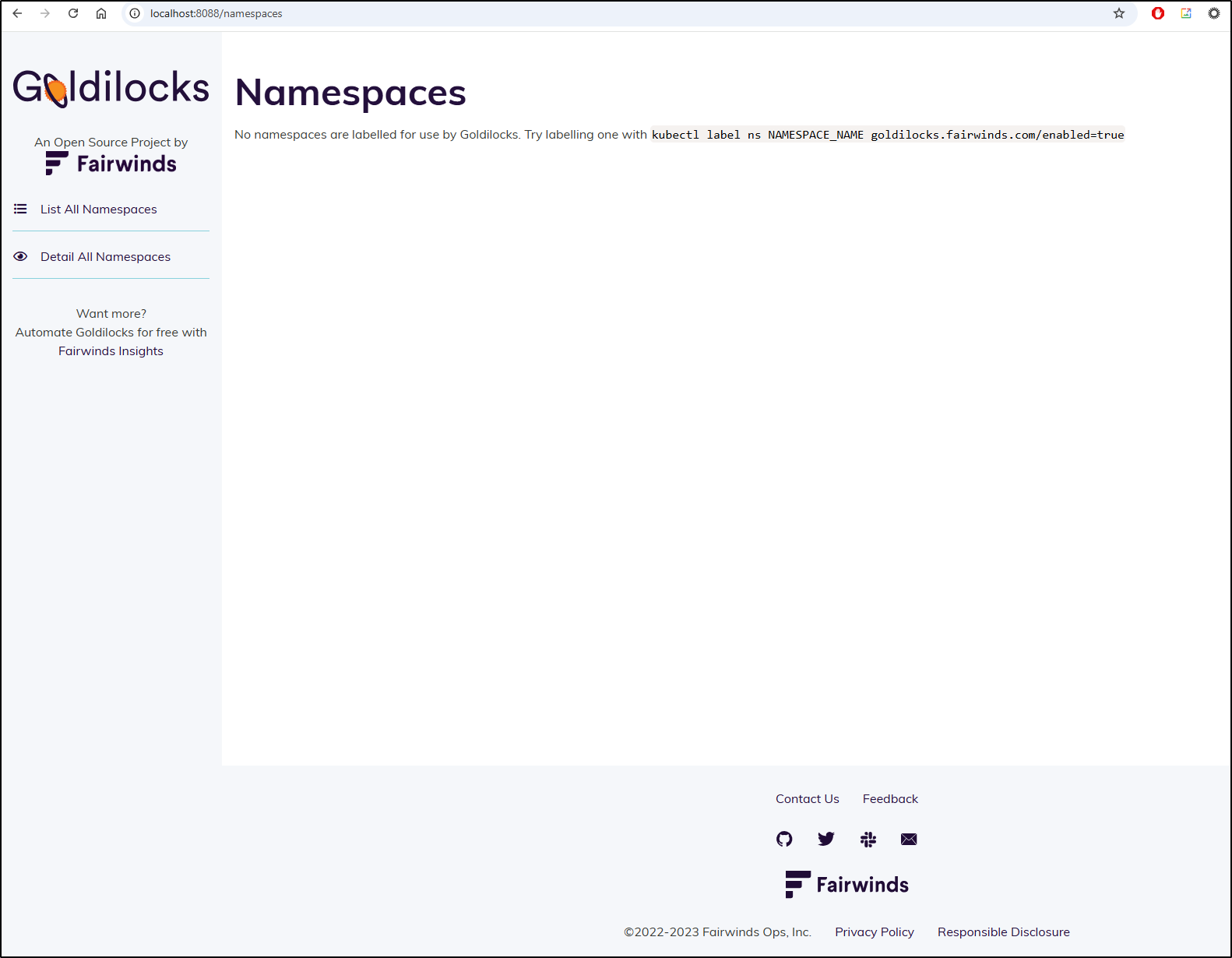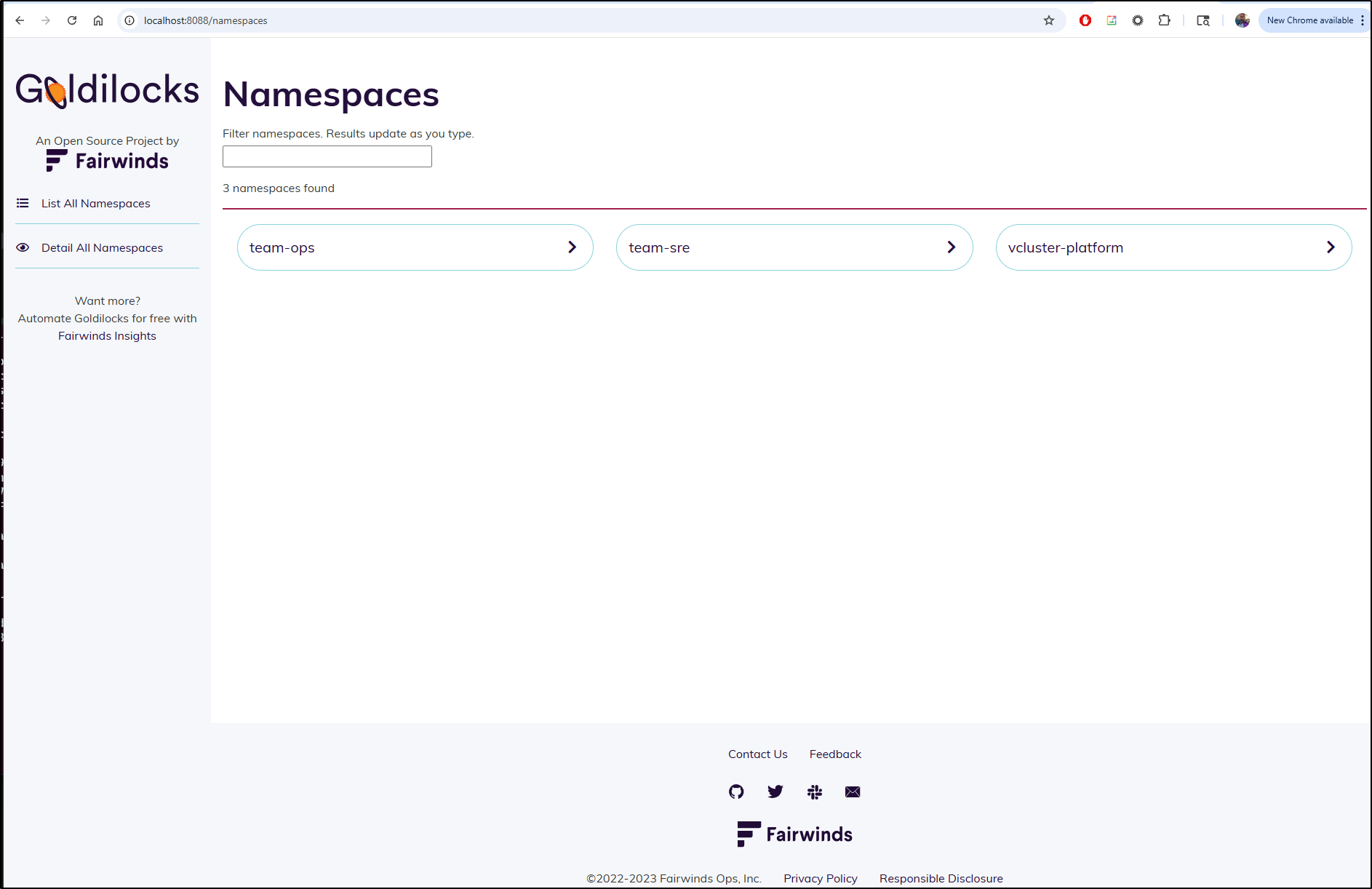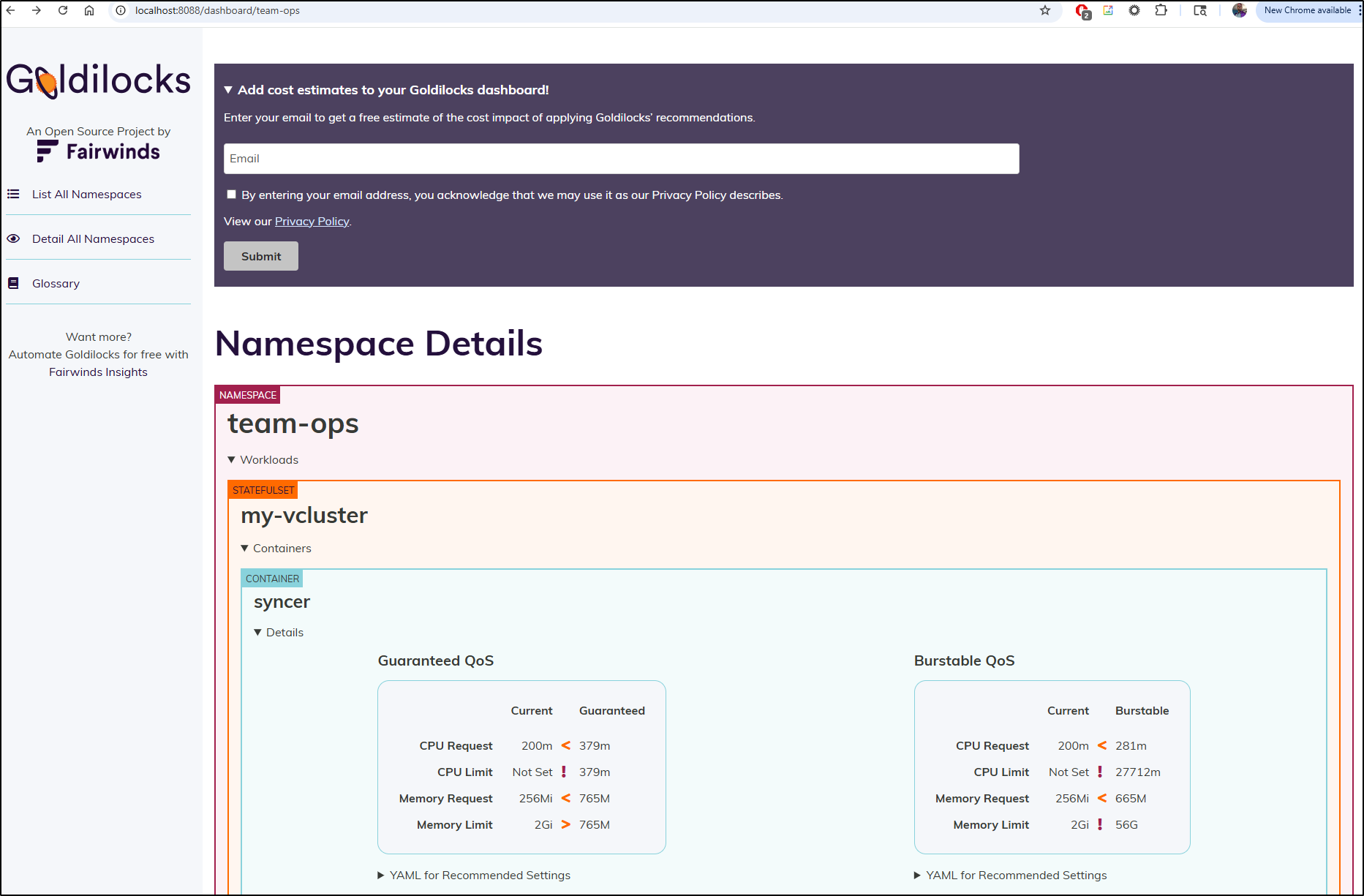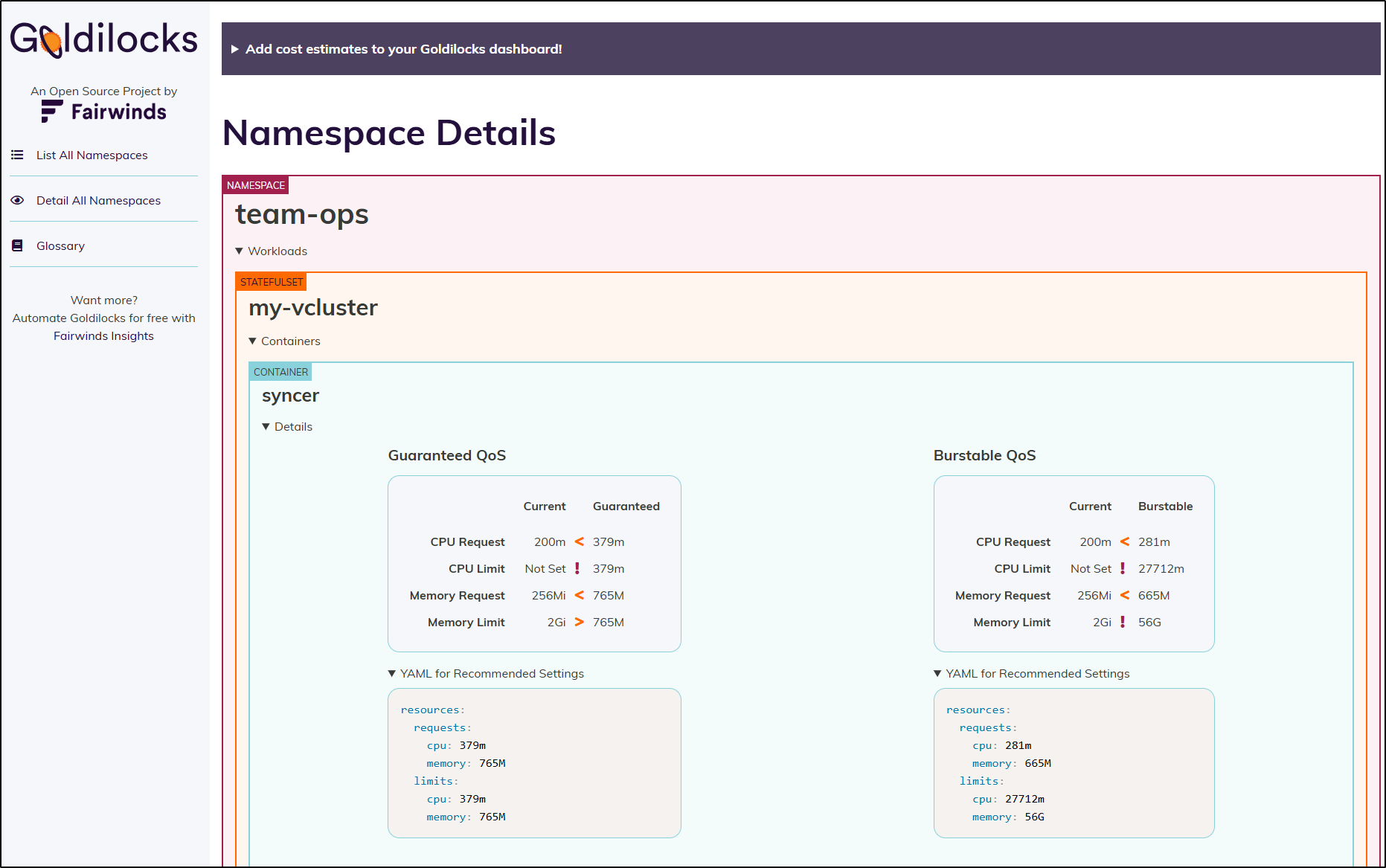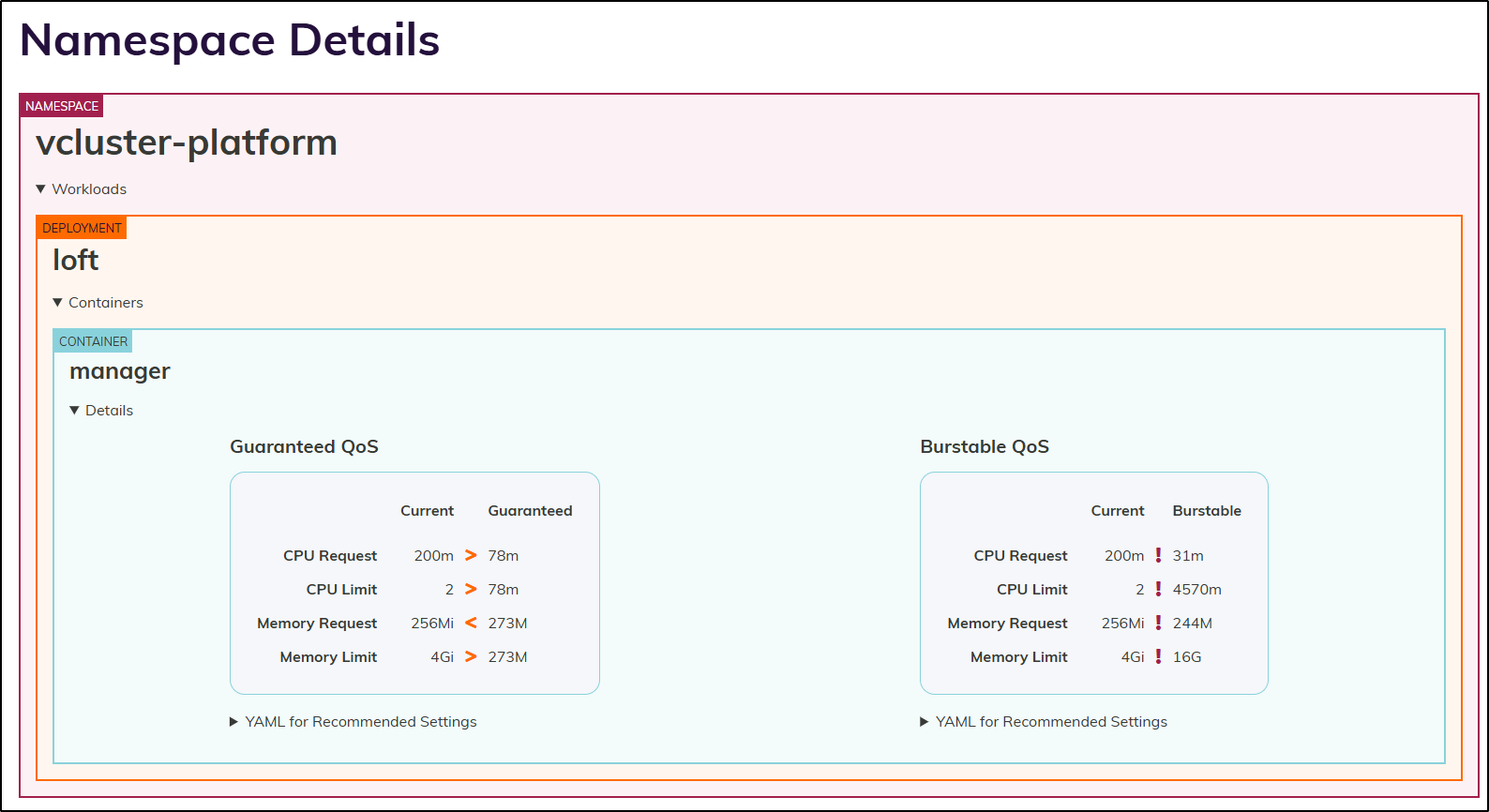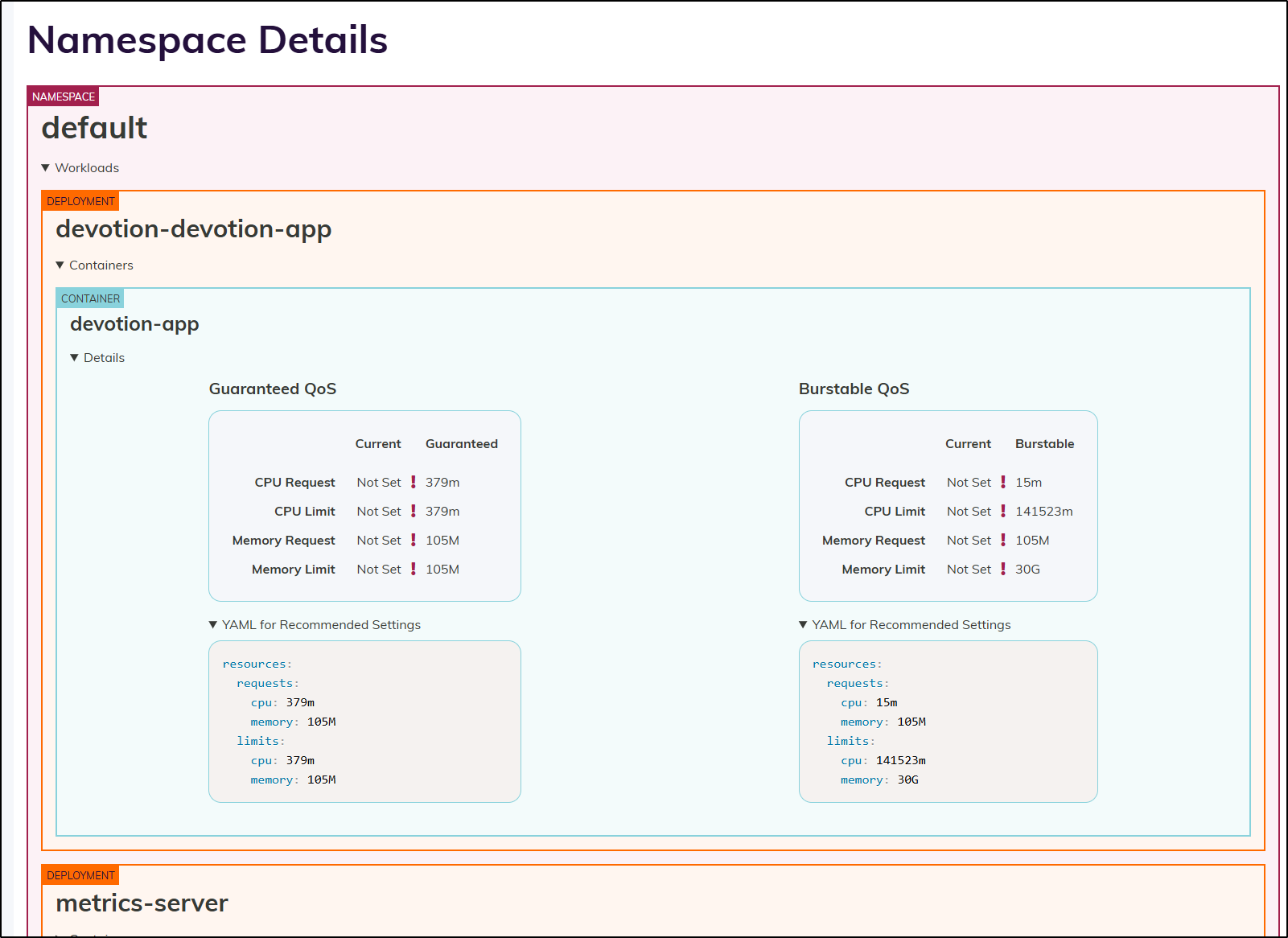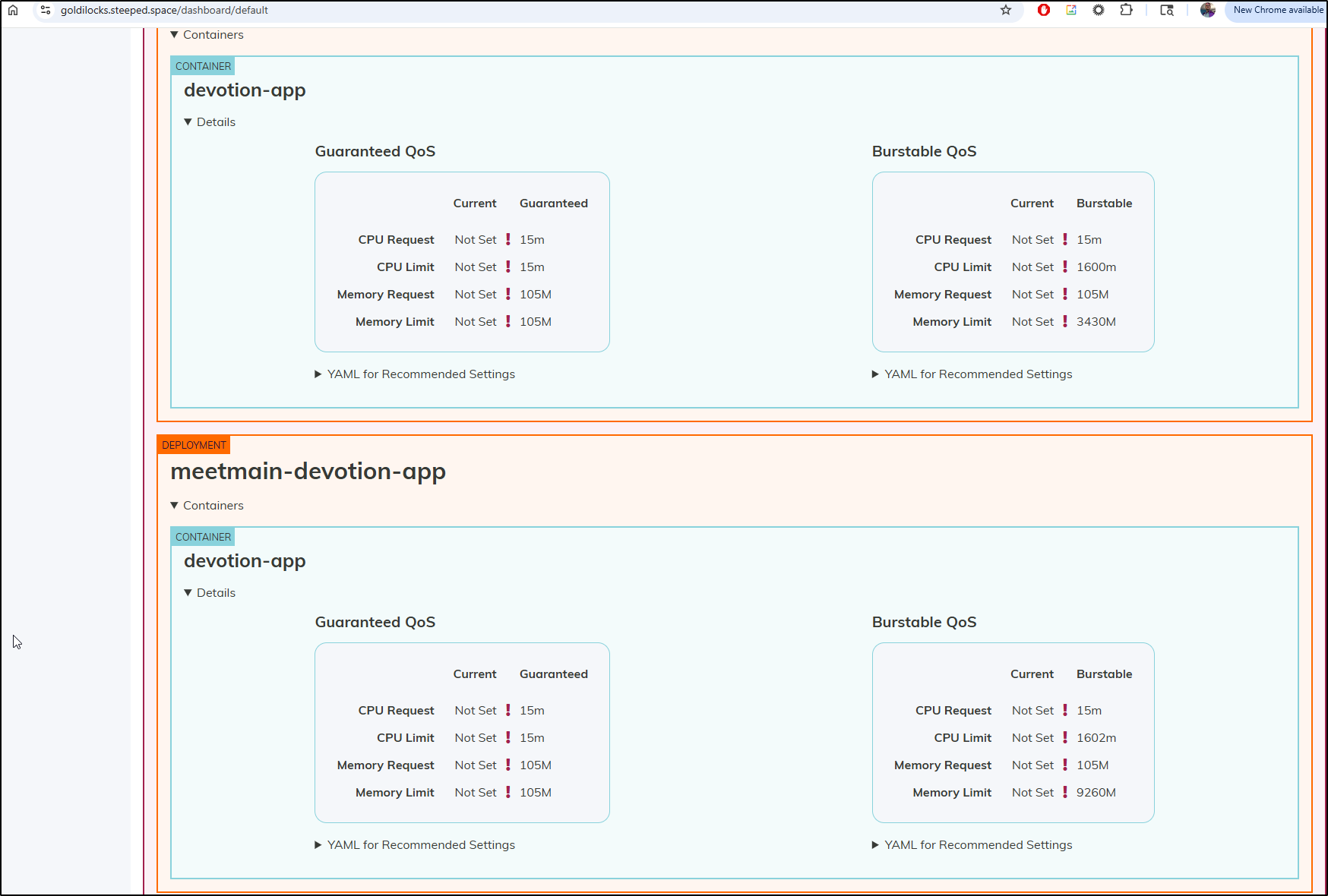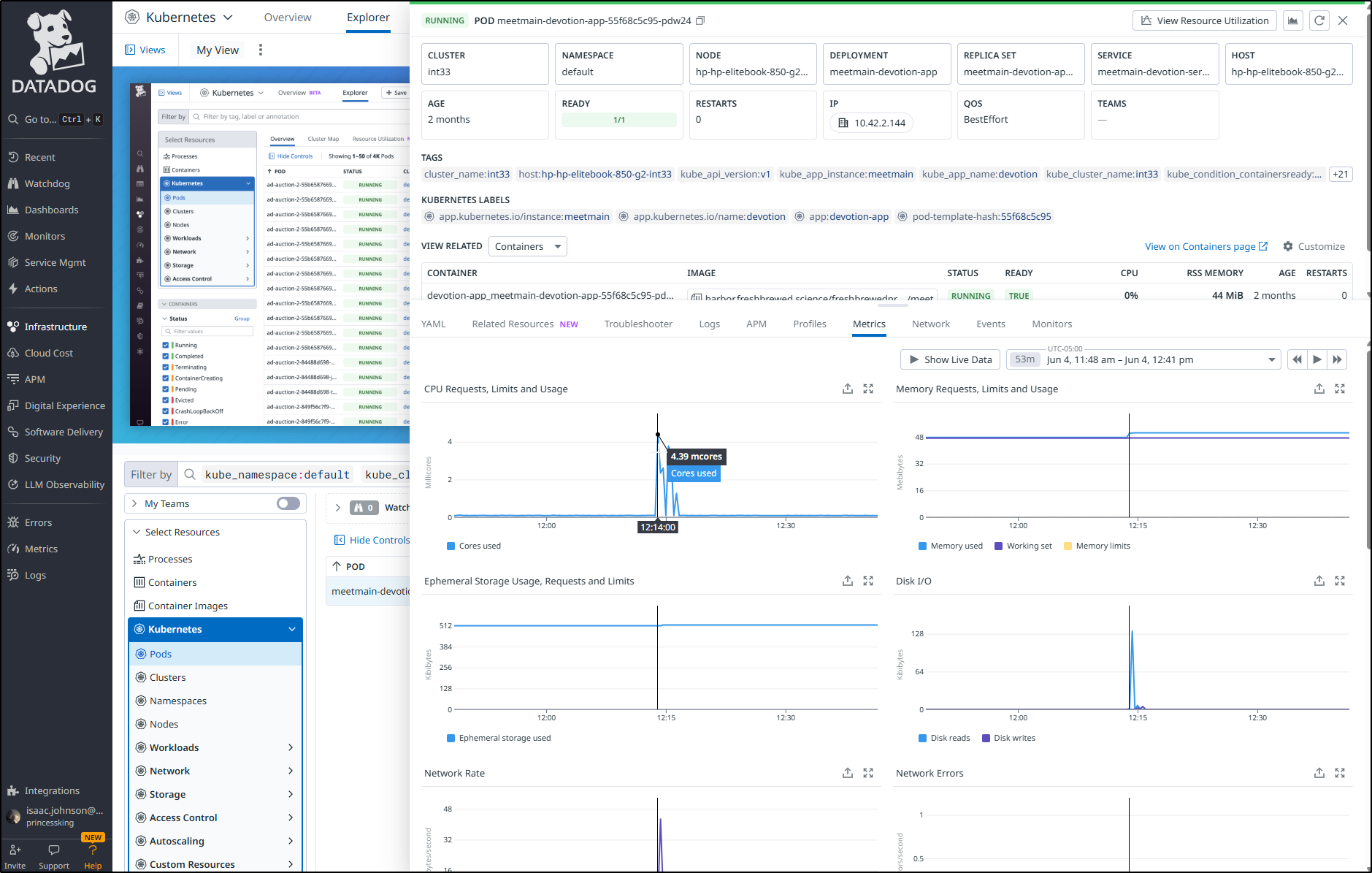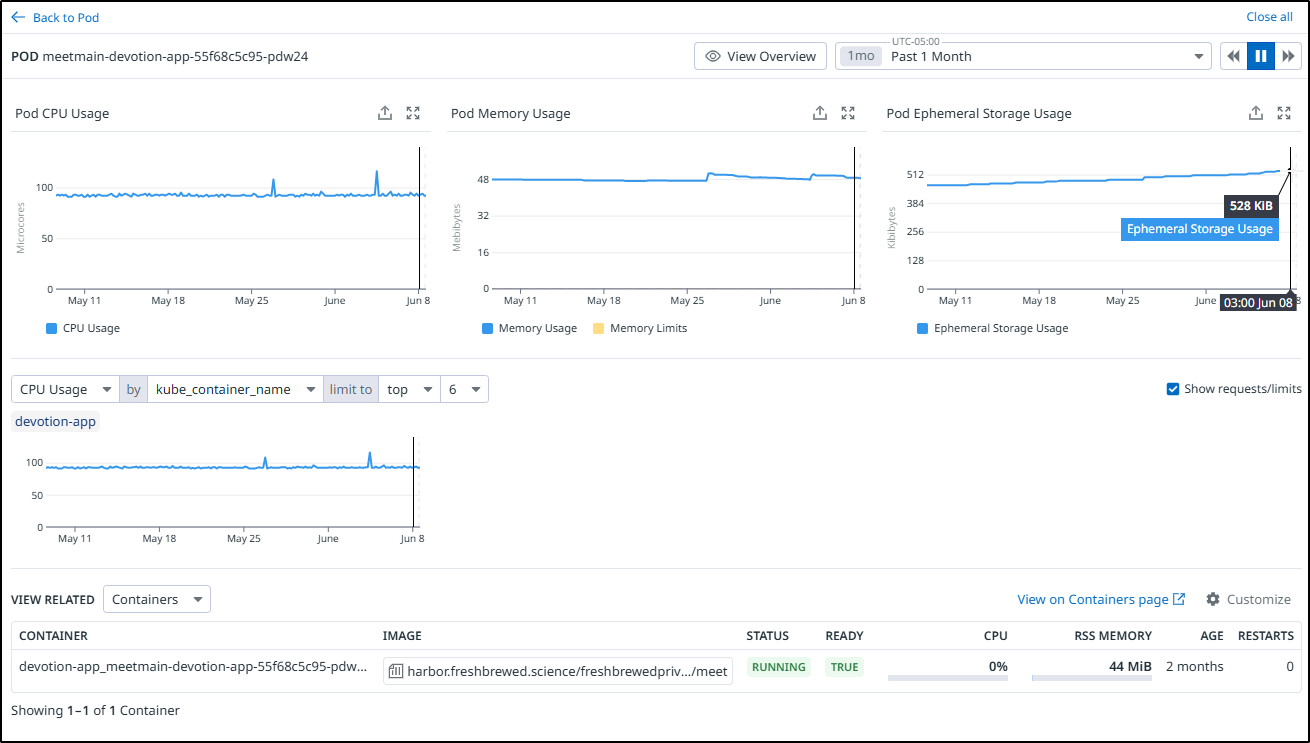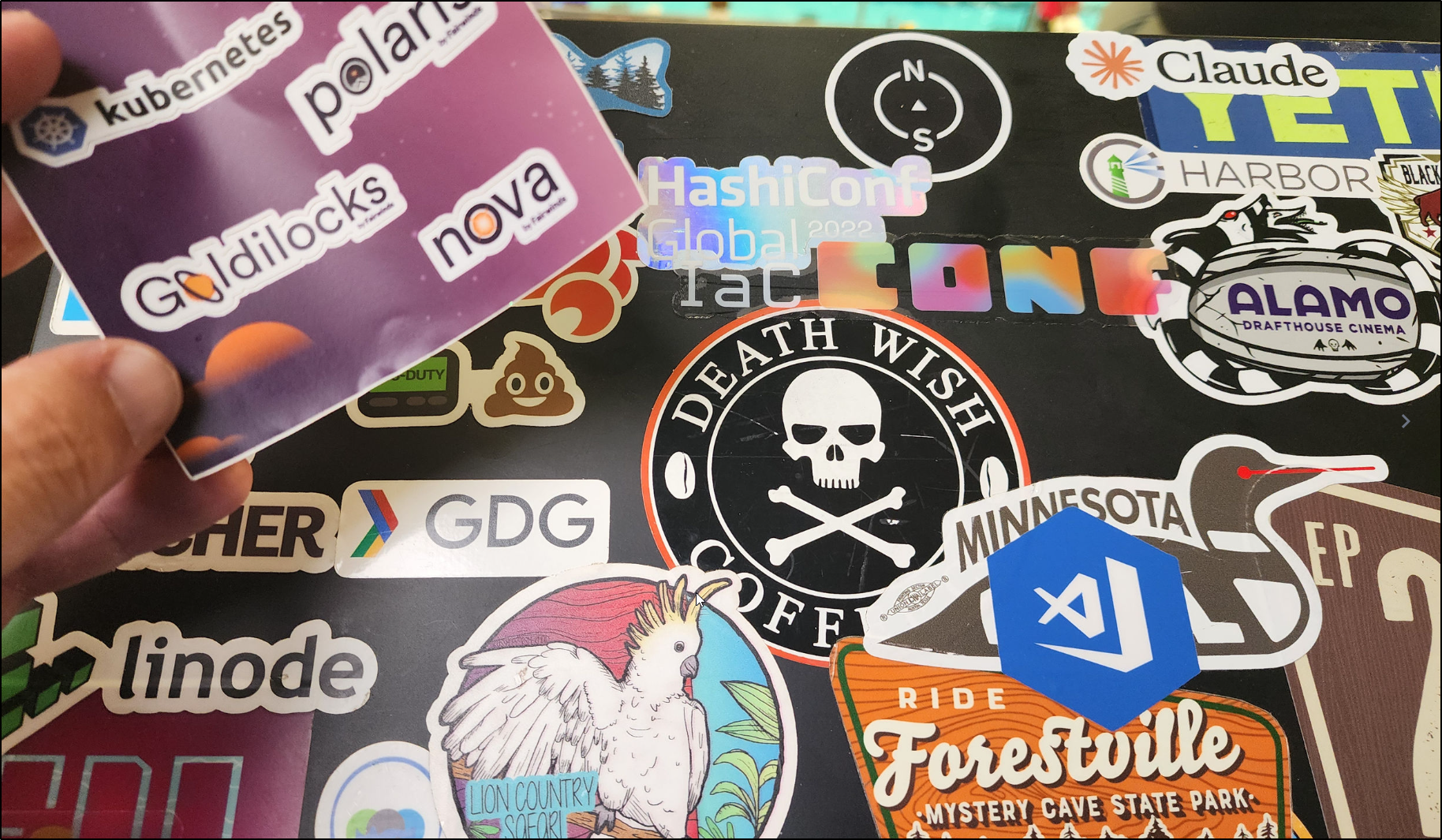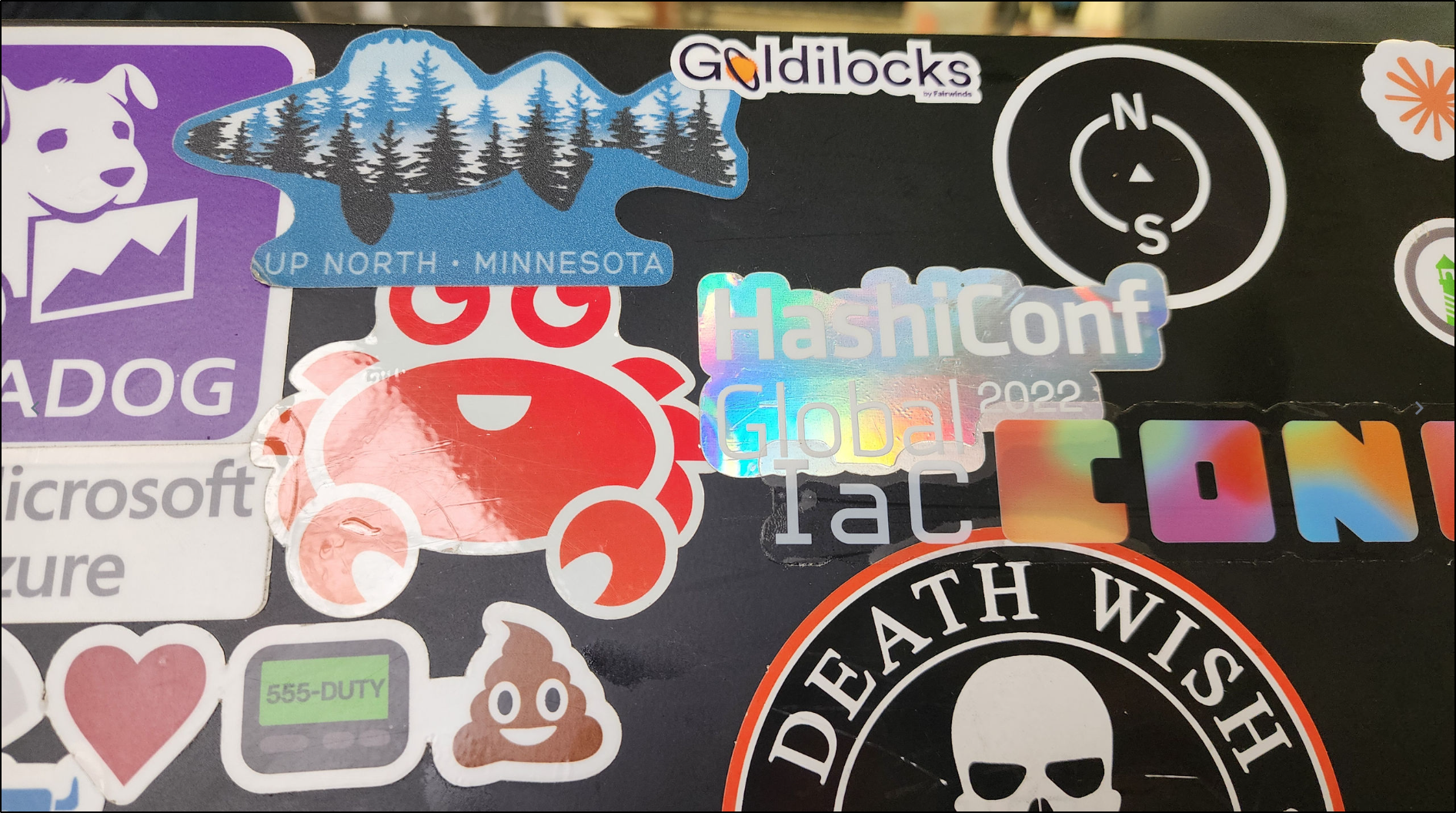Published: Jun 17, 2025 by Isaac Johnson
Fairwinds was an OSN sponsor this year and had a few interesting Open-Source projects I wanted to which I wanted to circle back. They are a managed service offering provider for GKE (see more), but what I think is really cool is they Open-Source a lot of their key tooling.
I have a sticker pack in my OSN bag with their more recently Open-Source offerings, so let’s check them out. The firt we’ll explore is Goldilocks.
Goldilocks
Goldilocks is a tool to answer the question “Well, what should be the right size for my pods?”. The CTO of Fairwinds was saying on a call how customers kept asking about needing help to determine their pods correct size and that’s how they came up with Goldilocks - not to small, not too big, but just right.
This sounds really interesting to me as in my own experience, right-sizing pods seems to be as much art as science and invariably becomes a heated discussion whenever we start to hit scaling issues.
Part of the reason it becomes contentious, in my opinion, is all sorts of monitoring and “costing” tools (such as Ternary and Kubecost) will suggest we “can save money” by reducing pods size but there are often consequences and there can be QoS and performance issues that come with smaller pod sizes.
Installation Pre-reqs
Before I can get started, I need to add a few key pieces.
First, we need to install a metrics-server if not there already
$ kubectl apply -f https://github.com/kubernetes-sigs/metrics-server/releases/latest/download/components.yaml
Warning: resource serviceaccounts/metrics-server is missing the kubectl.kubernetes.io/last-applied-configuration annotation which is required by kubectl apply. kubectl apply should only be used on resources created declaratively by either kubectl create --save-config or kubectl apply. The missing annotation will be patched automatically.
serviceaccount/metrics-server configured
Warning: resource clusterroles/system:aggregated-metrics-reader is missing the kubectl.kubernetes.io/last-applied-configuration annotation which is required by kubectl apply. kubectl apply should only be used on resources created declaratively by either kubectl create --save-config or kubectl apply. The missing annotation will be patched automatically.
clusterrole.rbac.authorization.k8s.io/system:aggregated-metrics-reader configured
Warning: resource clusterroles/system:metrics-server is missing the kubectl.kubernetes.io/last-applied-configuration annotation which is required by kubectl apply. kubectl apply should only be used on resources created declaratively by either kubectl create --save-config or kubectl apply. The missing annotation will be patched automatically.
clusterrole.rbac.authorization.k8s.io/system:metrics-server configured
Warning: resource rolebindings/metrics-server-auth-reader is missing the kubectl.kubernetes.io/last-applied-configuration annotation which is required by kubectl apply. kubectl apply should only be used on resources created declaratively by either kubectl create --save-config or kubectl apply. The missing annotation will be patched automatically.
rolebinding.rbac.authorization.k8s.io/metrics-server-auth-reader configured
Warning: resource clusterrolebindings/metrics-server:system:auth-delegator is missing the kubectl.kubernetes.io/last-applied-configuration annotation which is required by kubectl apply. kubectl apply should only be used on resources created declaratively by either kubectl create --save-config or kubectl apply. The missing annotation will be patched automatically.
clusterrolebinding.rbac.authorization.k8s.io/metrics-server:system:auth-delegator configured
Warning: resource clusterrolebindings/system:metrics-server is missing the kubectl.kubernetes.io/last-applied-configuration annotation which is required by kubectl apply. kubectl apply should only be used on resources created declaratively by either kubectl create --save-config or kubectl apply. The missing annotation will be patched automatically.
clusterrolebinding.rbac.authorization.k8s.io/system:metrics-server configured
Warning: resource services/metrics-server is missing the kubectl.kubernetes.io/last-applied-configuration annotation which is required by kubectl apply. kubectl apply should only be used on resources created declaratively by either kubectl create --save-config or kubectl apply. The missing annotation will be patched automatically.
service/metrics-server configured
Warning: resource deployments/metrics-server is missing the kubectl.kubernetes.io/last-applied-configuration annotation which is required by kubectl apply. kubectl apply should only be used on resources created declaratively by either kubectl create --save-config or kubectl apply. The missing annotation will be patched automatically.
deployment.apps/metrics-server configured
Warning: resource apiservices/v1beta1.metrics.k8s.io is missing the kubectl.kubernetes.io/last-applied-configuration annotation which is required by kubectl apply. kubectl apply should only be used on resources created declaratively by either kubectl create --save-config or kubectl apply. The missing annotation will be patched automatically.
apiservice.apiregistration.k8s.io/v1beta1.metrics.k8s.io configured
However, we can also use helm to install it
builder@LuiGi:~$ helm repo add metrics-server https://kubernetes-sigs.github.io/metrics-server/
"metrics-server" has been added to your repositories
builder@LuiGi:~$ helm upgrade --install metrics-server metrics-server/metrics-server
Release "metrics-server" does not exist. Installing it now.
NAME: metrics-server
LAST DEPLOYED: Sun Jun 8 13:12:42 2025
NAMESPACE: default
STATUS: deployed
REVISION: 1
TEST SUITE: None
NOTES:
***********************************************************************
* Metrics Server *
***********************************************************************
Chart version: 3.12.2
App version: 0.7.2
Image tag: registry.k8s.io/metrics-server/metrics-server:v0.7.2
***********************************************************************
Next, I’ll need a VPA (Vertical Pod Autoscaler) installed. Fairwind’s has a helm chart for that we can use:
builder@LuiGi:~$ helm repo add fairwinds-stable https://charts.fairwinds.com/stable
"fairwinds-stable" has been added to your repositories
builder@LuiGi:~$ helm install vpa fairwinds-stable/vpa --namespace vpa --create-namespace
NAME: vpa
LAST DEPLOYED: Sun Jun 8 13:15:03 2025
NAMESPACE: vpa
STATUS: deployed
REVISION: 1
NOTES:
Congratulations on installing the Vertical Pod Autoscaler!
Components Installed:
- recommender
- updater
- admission-controller
To verify functionality, you can try running 'helm -n vpa test vpa'
Note: not sure if was the weak wifi at a sporting event, but the helm install took a very long time with no output till the end
Goldilocks install
Let’s now move on to install Goldilocks with helm
$ helm repo add fairwinds-stable https://charts.fairwinds.com/stable
$ helm install goldilocks --create-namespace --namespace goldilocks fairwinds-stable/goldilocks
NAME: goldilocks
LAST DEPLOYED: Sun Jun 8 13:23:13 2025
NAMESPACE: goldilocks
STATUS: deployed
REVISION: 1
TEST SUITE: None
NOTES:
1. Get the application URL by running these commands:
kubectl -n goldilocks port-forward svc/goldilocks-dashboard 8080:80
echo "Visit http://127.0.0.1:8080 to use your application"
Checking that the pods are good
builder@LuiGi:~$ kubectl get po -n goldilocks
NAME READY STATUS RESTARTS AGE
goldilocks-controller-c96cbbd94-x8wd2 1/1 Running 0 8m59s
goldilocks-dashboard-5d486cdd4d-rgjjt 1/1 Running 0 8m59s
goldilocks-dashboard-5d486cdd4d-zxkgl 1/1 Running 0 8m54s
I can then port-forward to the service
builder@LuiGi:~$ kubectl get svc -n goldilocks
NAME TYPE CLUSTER-IP EXTERNAL-IP PORT(S) AGE
goldilocks-dashboard ClusterIP 10.43.253.69 <none> 80/TCP 9m44s
builder@LuiGi:~$ kubectl port-forward svc/goldilocks-dashboard -n goldilocks 8088:80
Forwarding from 127.0.0.1:8088 -> 8080
Forwarding from [::1]:8088 -> 8080
This brings up the dashboard
Clearly, we need to annotate a namespace to see some results with kubectl label ns NAMESPACE_NAME goldilocks.fairwinds.com/enabled=true
We can see that my test cluster has two vClusters as well as the vCluster system itself (from Loft)
builder@LuiGi:~$ kubectl get ns
NAME STATUS AGE
default Active 65d
goldilocks Active 12m
kube-node-lease Active 65d
kube-public Active 65d
kube-system Active 65d
p-default Active 36d
team-ops Active 36d
team-sre Active 37d
vcluster-platform Active 36d
vpa Active 20m
Let’s annotate those:
builder@LuiGi:~$ kubectl label ns team-ops goldilocks.fairwinds.com/enabled=true
namespace/team-ops labeled
builder@LuiGi:~$ kubectl label ns team-sre goldilocks.fairwinds.com/enabled=true
namespace/team-sre labeled
builder@LuiGi:~$ kubectl label ns vcluster-platform goldilocks.fairwinds.com/enabled=true
namespace/vcluster-platform labeled
I can now see those in the Goldilocks dashboard
Note: If you want default namespace, label it as well:
$ kubectl label ns default goldilocks.fairwinds.com/enabled=true
namespace/default labeled
Almost immediately we can see some recommendations
I am not that trilled with a massive purple banner trying to get me to signup for Fairwinds sales. Seems a bit “needy” to me.
That said, I can minimize it as well as see the YAML block I would use in my charts or manifests
I thought it was particularly interesting that for the guaranteed Quality of Service (QoS), it detected I put too low of values for the pods, but the memory limit was out of whack and the CPU limit did not exist.
While it doesn’t happen often, a runaway process can start to hog CPU and without a limit, Kubernetes won’t automatically replace the node. That’s a good catch, imho.
Loft’s vCluster platform also had recommendations
I then installed my “meet” app locally
$ kubectl get po
NAME READY STATUS RESTARTS AGE
devotion-db-migrate-9r22l 0/1 Error 0 6m33s
devotion-db-migrate-ksmsn 0/1 Error 0 3m39s
devotion-db-migrate-mk52b 0/1 Error 0 10m
devotion-db-migrate-qrltk 0/1 Error 0 8m12s
devotion-db-migrate-wlvkq 0/1 Error 0 9m12s
devotion-devotion-app-6c4d7b5bc-2m4dh 1/1 Running 0 4m24s
metrics-server-85f985c745-nzh4p 1/1 Running 0 75m
Here we can see some guidance on the missing requests and limits
Since I exposed those as a helm block, I can change the resources: {} to
... snip ...
size: 1Gi
replicaCount: 1
resources:
requests:
cpu: 379m
memory: 105M
limits:
cpu: 379m
memory: 105M
secrets:
sendgrid:
... snip ...
I upgraded via Helm to set them
builder@LuiGi:~/Workspaces/flaskAppBase$ vi values.yaml
builder@LuiGi:~/Workspaces/flaskAppBase$ helm upgrade --install devotion -f ./values.yaml ./helm/devotion
Release "devotion" has been upgraded. Happy Helming!
NAME: devotion
LAST DEPLOYED: Sun Jun 8 14:33:38 2025
NAMESPACE: default
STATUS: deployed
REVISION: 4
TEST SUITE: None
builder@LuiGi:~/Workspaces/flaskAppBase$ kubectl get po
NAME READY STATUS RESTARTS AGE
devotion-db-migrate-9r22l 0/1 Error 0 13m
devotion-db-migrate-ksmsn 0/1 Error 0 10m
devotion-db-migrate-mk52b 0/1 Error 0 16m
devotion-db-migrate-qrltk 0/1 Error 0 14m
devotion-db-migrate-s7ckq 0/1 Error 0 4m36s
devotion-db-migrate-wlvkq 0/1 Error 0 15m
devotion-devotion-app-6c4d7b5bc-2m4dh 0/1 Error 0 10m
devotion-devotion-app-9779dc69-bxzdm 1/1 Running 0 96s
metrics-server-85f985c745-nzh4p 1/1 Running 0 82m
While Golidlocks is happy with my memory settings, it now seems annoyed with my CPU settings. I don’t know why it would to limit to 15 millicores, but that would be a bit much. 379m, in CPU Request terms is about 1/3rd of a CPU.
I might try setting the request to 15m but not the limit.
Now, the question becomes is this based on the metrics gathered from Kubernetes or from some kind of pod inspection. I tend to think it’s the former which doesn’t help for a demo cluster with no load.
As nervous as this makes me, I think putting this into the production cluster is the only way to really see if it shines.
As it does not, by default, monitor all namespaces, just those we have annotated, I feel a bit safer.
Production
I can confirm my production server does have a metrics server already
$ kubectl get po -A | grep metrics
kube-system metrics-server-68cf49699b-274v6 1/1 Running 4 (66d ago) 463d
I’ll now install the Fairwinds VPA chart
$ helm install vpa fairwinds-stable/vpa --namespace vpa --create-namespace
NAME: vpa
LAST DEPLOYED: Sun Jun 8 14:45:19 2025
NAMESPACE: vpa
STATUS: deployed
REVISION: 1
NOTES:
Congratulations on installing the Vertical Pod Autoscaler!
Components Installed:
- recommender
- updater
- admission-controller
To verify functionality, you can try running 'helm -n vpa test vpa'
I’ll actually invoke that test this time to check the VPA was properly installed
$ helm -n vpa test vpa
NAME: vpa
LAST DEPLOYED: Sun Jun 8 14:45:19 2025
NAMESPACE: vpa
STATUS: deployed
REVISION: 1
TEST SUITE: vpa-test
Last Started: Sun Jun 8 14:46:47 2025
Last Completed: Sun Jun 8 14:46:47 2025
Phase: Succeeded
TEST SUITE: vpa-test
Last Started: Sun Jun 8 14:46:47 2025
Last Completed: Sun Jun 8 14:46:48 2025
Phase: Succeeded
TEST SUITE: vpa-test
Last Started: Sun Jun 8 14:46:48 2025
Last Completed: Sun Jun 8 14:46:48 2025
Phase: Succeeded
TEST SUITE: vpa-test
Last Started: Sun Jun 8 14:46:48 2025
Last Completed: Sun Jun 8 14:46:49 2025
Phase: Succeeded
TEST SUITE: vpa-test
Last Started: Sun Jun 8 14:46:49 2025
Last Completed: Sun Jun 8 14:46:49 2025
Phase: Succeeded
TEST SUITE: vpa-test-crds-available
Last Started: Sun Jun 8 14:46:49 2025
Last Completed: Sun Jun 8 14:47:08 2025
Phase: Succeeded
TEST SUITE: vpa-test-create-vpa
Last Started: Sun Jun 8 14:47:08 2025
Last Completed: Sun Jun 8 14:47:15 2025
Phase: Succeeded
TEST SUITE: vpa-test-metrics-api-available
Last Started: Sun Jun 8 14:47:22 2025
Last Completed: Sun Jun 8 14:47:26 2025
Phase: Succeeded
TEST SUITE: vpa-test-webhook-configuration
Last Started: Sun Jun 8 14:47:16 2025
Last Completed: Sun Jun 8 14:47:21 2025
Phase: Succeeded
NOTES:
Congratulations on installing the Vertical Pod Autoscaler!
Components Installed:
- recommender
- updater
- admission-controller
To verify functionality, you can try running 'helm -n vpa test vpa'
I can now add Goldilocks via Helm as I did on the test cluster
$ helm install goldilocks --create-namespace --namespace goldilocks fairwinds-stable/goldilocks
NAME: goldilocks
LAST DEPLOYED: Sun Jun 8 14:49:17 2025
NAMESPACE: goldilocks
STATUS: deployed
REVISION: 1
TEST SUITE: None
NOTES:
1. Get the application URL by running these commands:
kubectl -n goldilocks port-forward svc/goldilocks-dashboard 8080:80
echo "Visit http://127.0.0.1:8080 to use your application"
I’m also interested to track the Meet metrics so let’s annotate our default namespace
$ kubectl label ns default goldilocks.fairwinds.com/enabled=true
namespace/default labeled
I am going to expose this with ingress just to test, but do NOT plan to leave it live
$ gcloud dns --project=myanthosproject2 record-sets create goldilocks.steeped.space --zone="steepedspace" --type="A" --ttl="300" --rrdatas="75.73.224.240"
NAME TYPE TTL DATA
goldilocks.steeped.space. A 300 75.73.224.240
Then create and apply an ingress that can use it
builder@LuiGi:~/Workspaces$ cat ./goldilocks.ingress.yaml
apiVersion: networking.k8s.io/v1
kind: Ingress
metadata:
annotations:
cert-manager.io/cluster-issuer: gcpleprod2
kubernetes.io/ingress.class: nginx
kubernetes.io/tls-acme: "true"
nginx.ingress.kubernetes.io/proxy-read-timeout: "3600"
nginx.ingress.kubernetes.io/proxy-send-timeout: "3600"
nginx.org/websocket-services: goldilocks-dashboard
labels:
app.kubernetes.io/instance: goldilocksingress
name: goldilocksingress
spec:
rules:
- host: goldilocks.steeped.space
http:
paths:
- backend:
service:
name: goldilocks-dashboard
port:
number: 80
path: /
pathType: ImplementationSpecific
tls:
- hosts:
- goldilocks.steeped.space
secretName: goldilocks-tls
builder@LuiGi:~/Workspaces$ kubectl apply -f ./goldilocks.ingress.yaml -n goldilocks
ingress.networking.k8s.io/goldilocksingress created
When I see the cert is satisified
builder@LuiGi:~/Workspaces$ kubectl get cert -n goldilocks
NAME READY SECRET AGE
goldilocks-tls False goldilocks-tls 23s
builder@LuiGi:~/Workspaces$ kubectl get cert -n goldilocks
NAME READY SECRET AGE
goldilocks-tls False goldilocks-tls 44s
builder@LuiGi:~/Workspaces$ kubectl get cert -n goldilocks
NAME READY SECRET AGE
goldilocks-tls False goldilocks-tls 58s
builder@LuiGi:~/Workspaces$ kubectl get cert -n goldilocks
NAME READY SECRET AGE
goldilocks-tls True goldilocks-tls 72s
I can now access it at https://goldilocks.steeped.space/
I’ll now leave this live for a few days to see if the settings change
Datadog
This is where having a monitoring suite like Datadog comes in real handy.
I can view my pods for the deployment over the last month and zoom in on a spike time
I can view “Resource Utilization” to see it’s basically just shy of 100 microcores and 44mb of memory most of the time, but storage (however small) does tend to creep up
Summary
I don’t do this often, but I think Goldilocks has earned a place on the lid
Appropriately near the OSN sticker
Disclosure
I had to search this up because I think I might have been the winner of their booth giveaway and indeed I was!
They had this glorious Micro Journel
Which I gave to my middle daughter who uses it often for writing
While this had no bearing on me deciding to dig in on their OS solutions, I felt it worth brining up.
Editors Note
The domain “steeped.space” has since been retired. All work that would have been there is now on “steeped.icu”. Thus any links you see above mentioning “goldilocks.steeped.space”, for instance, really would be valid now on “goldilocks.steeped.icu”.


